The whole history of PocketBook in one article: from PocketBook 301 2008 to the new line of autumn 2016
Pocketbook- manufacturer of portable electronic books, readers. A company with a really rich history. I have more or less closely followed its activities since its inception, that is, since 2008. But now, when I began to poke around on this issue with special care (for writing this post), I realized that earlier I had followed the company's novelties precisely that it was “more or less”, that is, not very carefully. Because offhand, I could remember 10-15 pieces of pocketbooks, and there were more than 30 of them - PocketBook is the leader in the number of models released in the entire history of the reader market, no one else, nor any other manufacturer from this segment. And this, I emphasize, only devices with E Ink screens, that is, on electronic inks. Models with TFT displays will be left behind the brackets this time - yet the key direction for PocketBook development has always been the E Ink screen readers. And the company has achieved in this field, I’m not afraid of such a big word, of giant success: it was PocketBook that actually formed the market of readers in Russia in 2008-2009. And from its very inception essentially led it. And it continues to sit on top all these years right up to today - with a mass of curious models and a market share of about 70%. However, the mass of models, and the proportion of 70% - all this will be later. And it continues to sit on top all these years right up to today - with a mass of curious models and a market share of about 70%. However, the mass of models, and the proportion of 70% - all this will be later. And it continues to sit on top all these years right up to today - with a mass of curious models and a market share of about 70%. However, the mass of models, and the proportion of 70% - all this will be later.

In the meantime, let's imagine that in the yard ...
That year, PocketBook entered the reader market. The company's firstborn, the PocketBook 301 model , became a real hit: in two years or more, by the end of 2010, more than 100 thousand copies of the device were sold in Russia alone. Given that the entire volume of the Russian market of book readers for these three years (2008, 2009, 2010) was estimated by analysts at less than one million. That is, PocketBook 301 - only one model, for a minute - in terms of sales, it took more than 10% of the total domestic reader market. Thus, PocketBook 301 has become the most popular reader in Russia in the history of this class of gadgets. And to break the record in the future, no other model failed.

PocketBook 301 - reader with record sales. Offered in several versions. Some went with a memory card and a cover, and some had a minimum grade
We will not hide: there were certain claims to PocketBook 301. In particular, individual users complained about the unreliability of E Ink. Like, almost a finger hit him - and he took and broke. (And replacing the display at that time cost about 70% of the price of a new reader - and it was easier to buy a new reader than to change the screen.) This really was the case, but the blame should be not PocketBook, but the company E Ink, the manufacturer of similar displays. Its developments of that time really did not differ in reliability. And users blamed PocketBook only because of the popularity of the PocketBook 301 model, although the problem with the “battle” of the screens was absolutely for all reader brands. If, say, Samsung sells a million smartphones, of which 1% will be defective, then theoretically 10 thousand users can write about it on the Internet. But HTC, for example, will sell 100 thousand smartphones, and the level of marriage it will be exactly the same - 1%. How many people can face it (marriage)? That's right, a thousand. That's the same with the PocketBook 301: this model was sold at times better than others, and therefore the noise on the Internet due to problems with the displays of this particular model was much more than about the reader of other brands.
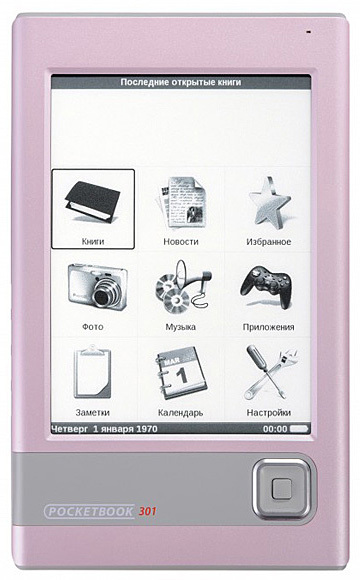
PocketBook 301 was available even in glamorous pink colors - 7 years before the iPhone 6s!
Anyway, the PocketBook 301 still continued to buy almost avidly. Because, firstly, this reader was the most thoughtful software - one support for 12 formats of books was worth. By the way, in the future, the number has grown to a maximum for the market - as much as 18; and that's against Kindle 6 and 10-12 for most other competitors.
The software design of the PocketBook 301 model is a consequence of the presence in the PocketBook team of the backbone of programmers from the countries of the former USSR, namely from Russia, Ukraine, Belarus. They perfectly understood and understand the domestic realities - for example, the need for support by the reader FB2, the most popular book format in the CIS. In Amazon, for example, they don’t see any point in supporting FB2, because they don’t care about Russian realities. Secondly, PocketBook 301 as a whole was a high-quality, complete product without obvious “jambs”. This is very important, since it was then, in 2008–2009, that a “reader boom” began in Russia, and everything from China began to carry reading rooms. And most of them brought that slag that-it was painful to watch. PocketBook, on the contrary, set a very high level of quality. What exactly and led to an avalanche-like growth in sales of the first model, and then to leadership: by 2011, PocketBook already controlled about 40% of the electronic reader market. By 2016, the share of PocketBook on the Russian reader market has increased, almost to 70%.
This year, the PocketBook has already released two new readers. The first was the model PocketBook 360. In the case of PocketBook 301, they took the finished development of Netronix (in particular, the case and hardware) and, after finishing it thoroughly from the software and engineering points of view, got the PocketBook 301 itself. But the PocketBook 360 is a completely authentic development - the model was made from scratch, since in 2009, Pocket acquired its own fully formed team of hardware engineers. This was the key difference between the PocketBook and all the players of the Russian reader market at the time: they brought devices with their own logo from China (in 99% of cases, the devices were crooked, oblique and of poor quality), but the PocketBook has since trusted the Asians only. The development of the devices was carried out up to now, that is, up to the present moment, is conducted by the specialists of the company.

PocketBook 360 - the first reader in the world, developed according to the wishes of consumers. It was completed with a cover to protect the screen
PocketBook engineers created a theme on the-ebook.org Russian forum and collected user suggestions for three months - the latter thought and wrote what they would like to see in the new reader model. The result was PocketBook 360 - the first and so far the only reader in the world, entirely created on the basis of the wishes of ordinary people. The model was made compact, 5-inch, plus they implemented a number of extremely unusual for that time chips. For example, a plastic cover for the screen - it protected the display from various objects in bags, pockets and backpacks. And for the first time in PocketBook 360 (in the case of readers, of course) a gyroscope was implemented: the image on the screen automatically rotated depending on the position of the reader in space. Hence, in fact, the number 360 in the title. Plus, the design of the PocketBook 360 was very pleasant: In general, the reading rooms of that time looked scary, but this model could be called pretty - including thanks to the pattern on the protective cover. This reader was eagerly bought by the girls, who, in addition to the design of the attractive design, were attracted by the compactness of the PocketBook 360 - the reader could easily fit even into a miniature handbag.
The second novelty of 2009 is PocketBook 302 Cookie . It’s also an innovative reader in many respects: it became the first touchscreen (though resistive - that is, not very convenient) pokerbook. In addition, PocketBook 302 Cookie immediately offered five options for downloading books to memory: from the Internet via Wi-Fi (it was a simple browser), from a computer or smartphone via Bluetooth, from a computer using a cable, as well as via a MicroSD card and USB flash drives. Most of these methods were later abandoned: the Internet has become faster and more accessible, and MicroSD is now no more expensive than conventional USB flash drives. So Bluetooth and USB host are no longer needed. But then, in 2009, PocketBook 302 Cookie in terms of convenience and technology tore all competitors to shreds.
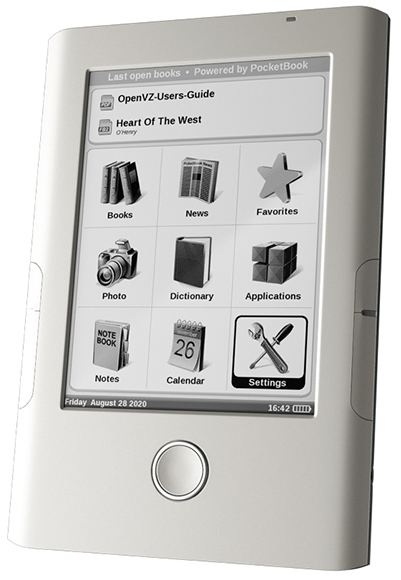
PocketBook 301 Cookie could be controlled with both fingers and a stylus. But the pen reader listened better, given the resistive touchscreen technology.
This year was very successful for PocketBook - in the sense that the company released a whole galaxy of successful models. Namely, the Pro line, which included PocketBook Pro 602, 603, 902 and 903 . All of these models were made in factories Foxconn - Taiwanese company that assembles the iPhone, iPad and other Apple products.
PocketBook Pro 603 and 903 models have become the world's first readers with a full smartphone set of wireless modules - Bluetooth, Wi-Fi and 3G. Yes, yes, it was possible to insert a SIM-card into the reader and then buy e-books in the company's PocketBook-BookLand store (which, by the way, has since been pre-installed into all PocketBook readers with access to the Web). Well, just to surf the Internet through the browser, too, no one forbade. Actually, why was 3G needed if the readers supported Wi-Fi? Well, today Wi-Fi is almost in every first cafe and even in buses and subways, but then, in 2010, with free networks everything was a bit more complicated. And to ensure constant and uninterrupted access to the Internet, 3G was indispensable. Later, with the final popularization of Wi-Fi, PocketBook from 3G modems in the readers completely refused.
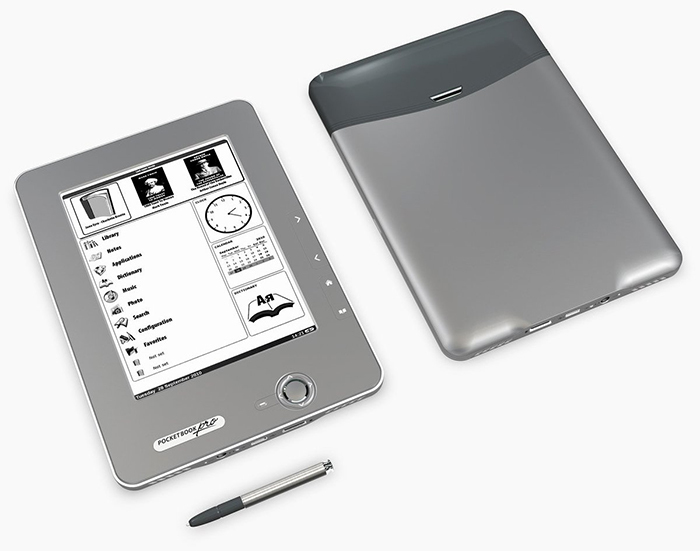
The package of PocketBook Pro 603 and 903 left pen. The models looked the same, unless, of course, we take into account the dimensions. In the picture - PocketBook Pro 603.
Also PocketBook Pro 603 and 903 received inductive touch screens - with support for stylus control. Such displays did not react to the fingers, but the pen presses were processed much more accurately than the PocketBook 302 Cookie with its resistive screen. Well, here, perhaps, I would say that PocketBook Pro 902 and 903 were the company's first readers in a large-format 9.7-inch form factor. Such a hefty reader with high resolution (1200 x 825 pixels) for technical and scientific literature, which, due to the presence of a heap of small symbols, requires just large screens.
PocketBook Pro 602 and 902 did not have touch screens and 3G modems. Otherwise, they did not differ from their more expensive counterparts - PocketBook Pro 603 and 903, respectively.
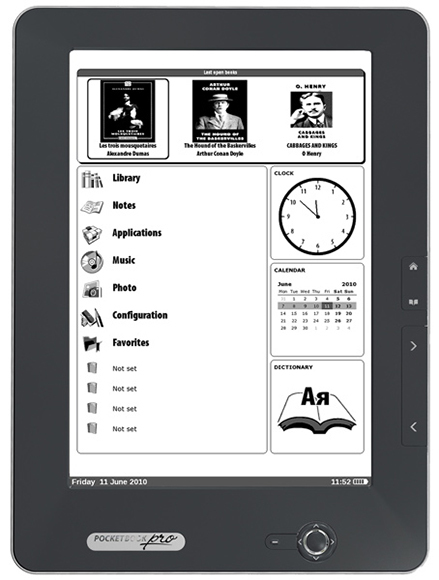
Well, this is PocketBook Pro 902. Model PocketBook Pro 602 looks the same, only more compact.
All Pro-series models have rear panels made from magnesium-aluminum alloy: this significantly increased the torsional rigidity of the cases and, as a result, almost completely solved the problem of cracked screens E Ink, which took place in the early models of the company. However, the solution with the above-mentioned alloy was temporary: 6-inch PocketBook Pro 602 and 603 weighed 255 and 280 g, respectively. That for models in such a form factor is quite a lot: today 6-inch diagonal billboards weigh about 180 g. In general, steps were required from E Ink, which was supposed to increase the reliability of its screens. However, E Ink will only do this in a year.
It is worth noting the presence in PocketBook Pro 602, 603, 902 and 903 of a number of audio features. If ordinary MP3 players were also in PocketBook 301 and PocketBook 301 Cookies, then “proshki” also received the ability to play text by voice - the Text-to-Speech function. That is, ordinary books by the software of the reader could turn into audiobooks, which previously no single reader of any other manufacturer could do.
And in PocketBook Pro 602, 603, 902 and 903 for the first time (and not only for PocketBook models, but also for the reader market as a whole), ABBYY dictionaries and a number of other manufacturers appeared, which are still used in all PocketBook models. The principle of operation of the dictionaries is this: you highlight a word in the text - and then you get a translation. Later, this implementation became the standard for the reader market, and it was happy to “beat” dozens of other companies.
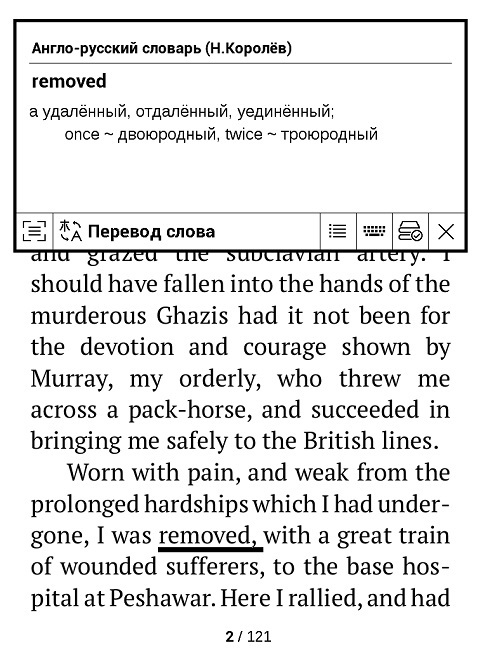
Back in 2010, the first wave of attempts to introduce readers into schools as electronic textbooks began. Anatoly Chubais himself compared in his blog the reader Plastic Logic 100 from RUSNANO with PocketBook Pro 902 - they say, let's see which one is better suited for the needs of education. Of course, Anatoly Borisovich won his native Rosnan Plastic Logic. However, the Plastic Logic 100 project eventually died, and was not born, but PocketBook readers — however, models 903, not 902 — were successfully implemented in a number of schools in Russia and Ukraine. Then, in 2010, a prototype reader for PocketBook 901 schools was created.. It was originally created for educational institutions, that is, from scratch, it was not based on any other reader. PocketBook believed that it was better for schools to create a separate product, but the success of the implementations in schools of PocketBook Pro 903 showed that it is quite possible to do without a completely new model represented by PocketBook 901. Therefore, massively this model, alas, was not released.

PocketBook 901 occasionally met in stores, although they didn’t start mass production of this model
2011 was, so to speak, a year of evolution: PocketBook offered only one radically new model, plus well-updated old ones. For example, PocketBook 360 Plus has replaced the legendary PocketBook 360 : the processor frequency has increased from 400 to 533 MHz, and Wi-Fi support has been added. On this updated reader, for the sake of demonstrating the power of iron, they even launched Doom II - for the first time on devices with E Ink screens, a game with such 3D graphics was launched:
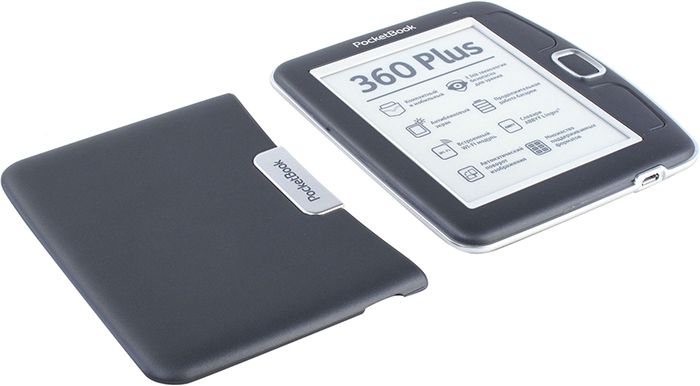
PocketBook 360 Plus has become faster than its predecessor and has learned how to access the Internet, as well as play Doom II
Models PocketBook Pro 612 and 912 - this is a cross between 602/603 and 902/903, respectively. PocketBook Pro 612 and 912 have lost 3G modems, however, inductive touchscreens remain in them. PocketBook Pro 912 was also released in the Education version - with an electronic diary and other applications necessary for the school. The model also experienced a number of successful implementations in educational institutions.

The new line of "proshki" included only two models - PocketBook Pro 612 and 912. Both with touch screens, but without 3G modems.
But the PocketBook 611 Basic became a radically new model in 2011 . It was the first time that new E Ink screens were used in it - with the same image quality as before, but less fragile. This allowed to abandon the protective covers and metal in the enclosures. Therefore, the 6-inch PocketBook 611 Basic weighed only 175 g - as much as 80 g less than the same PocketBook Pro 602.
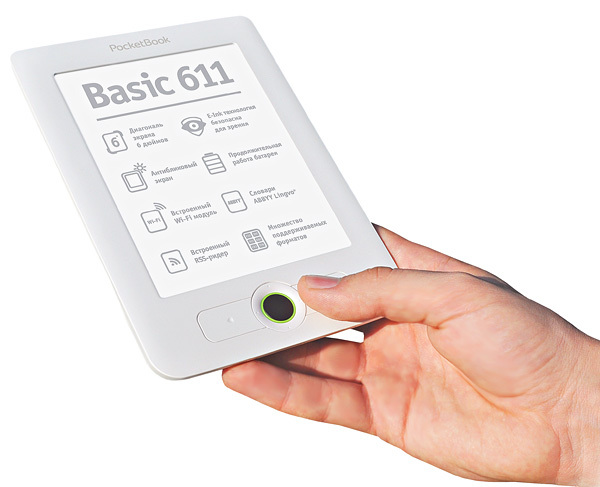
PocketBook 611 Basic has become the first reader with an improved E Ink screen - not in terms of image quality, but in terms of reliability. This allowed for a lightweight plastic case.
What did PocketBook do this year? First, they made PocketBook 611 Basic cheaper - the PocketBook 613 Basic New model was released . The essence is the same, but with minor improvements in the software and without the support of Wi-Fi.

There is no Wi-Fi, a slightly different form of buttons - that's all the changes compared to PocketBook 611 Basic
Another update has undergone and PocketBook 360: PocketBook 360 Plus version was turned into PocketBook 360 Plus New . Innovation - overclocked to 800 MHz processor, which also found application in PocketBook 611 Basic, PocketBook 613 Basic New and PocketBook 622 Touch.
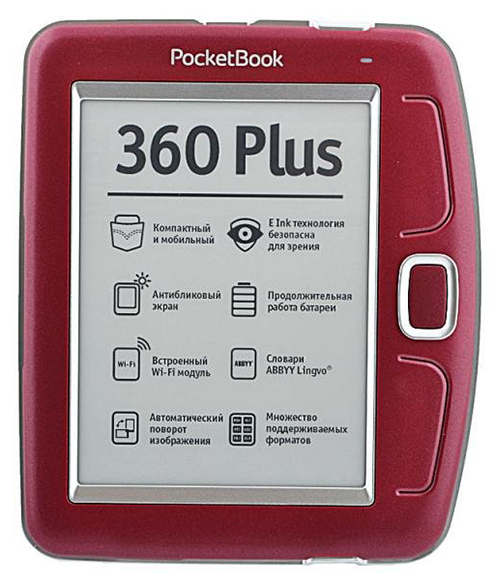
A faster processor is the only significant difference between the PocketBook 360 Plus New and the previous version called PocketBook 360 Plus.
Actually, PocketBook 622 Touch- the third and most important novelty of 2012. This model was the first poketbukom screen E Ink Pearl and the first - with a capacitive touchscreen and support for multitouch. That is, it was possible to scale the text by mixing and spreading fingers, which is very convenient. Just like on the iPad. The case of the PocketBook 622 Touch is plastic, as is the case with the Basic series models - due to the increased reliability of the E Ink screens and the competent design of the cases from the PocketBook side, the problem of “combat” of displays began to appear rarely. Among other features of the PocketBook 622 Touch, it is worth noting support for Wi-Fi, an MP3 player, Text-to-Speech, and a new design that has become classic, which has been used with minimal edits so far.
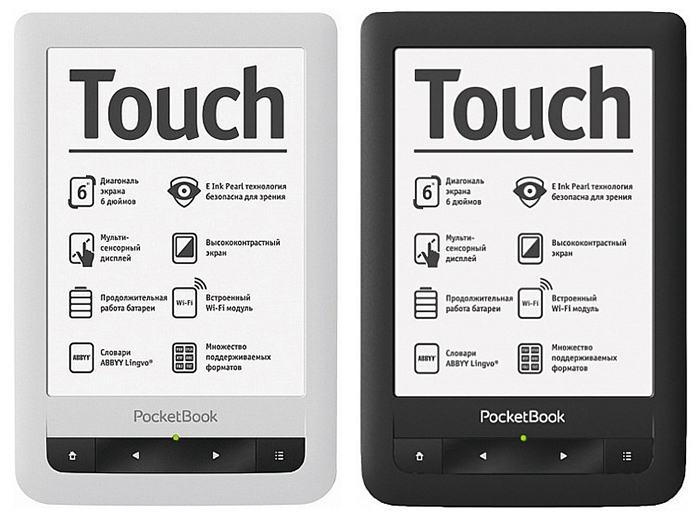
PocketBook 622 Touch was the first among the PocketBooks to receive the E Ink Pearl screen. Plus, he got a design that later became a classic for most of the company's 6-inch sensor readers.
It is also worth remembering about the first of its kind service for bibliophiles ReadRate - its first test version was launched in 2012 (the final one in 2014). It allows people to talk about recently read books and publications that they only plan to meet, as well as learn about the book habits of their friends. In addition, the function of "likes" and comments, as well as integration with other social networks. By the end of 2016, ReadRate has about 160 thousand users - this is not very much compared to VKontakte and some Odnoklassniki, where millions go by, and still quite a lot to find a good book for yourself.
This year was extremely fruitful. Firstly, it is worth noting the fact that PocketBook has begun to massively use E Ink Pearl screens in its devices - lighter, clearer and more generally better. In all the models described above, except for PocketBook 622 Touch, E Ink Vizplex screens were installed - they were quite good for their time (better than the same Sipix), but they are inferior to Pearl at least in image clarity.
PocketBook 623 Touch 2Received not just the E Ink Pearl screen (800 x 600 pixels), but Pearl HD (1024 x 758 pixels). And the backlight system - for the first time for Pocketbooks. Plus, synchronization with Drobpox appeared: you throw a book on the computer into a folder - and it appears in the reader after a minute. In general, the flagship of the 2013 model. Moreover, the model is relevant to this day - for example, the author of this text still exploits PocketBook 623 Touch 2. And it is not going to change it for anything. Just because the reader is not a tablet, the readers do not lose their relevance a year later, and after two, and after five. Reducing the capacity of the battery does not make them worse (well, the reader worked for a month, and then three weeks sal - is the difference great?), And the display quality of the books does not change with time.

PocketBook 623 Touch 2 - the first backlit with the backlight and the first with the E Ink Pearl HD screen.
The PocketBook 624 Basic Touch is also released in 2013. By design, it is similar to the PocketBook 623 Touch 2, but there is no backlight and MP3-player embracing Text-to-Speech - for the sake of lower prices. Well, the screen has a resolution of 800 x 600 pixels, not 1024 x 758. That is, the PocketBook 624 Basic Touch 2 had the usual Pearl, not the Pearl HD. But the hardware platform is slightly more powerful: the processor frequency was raised from 800 MHz to 1 GHz.
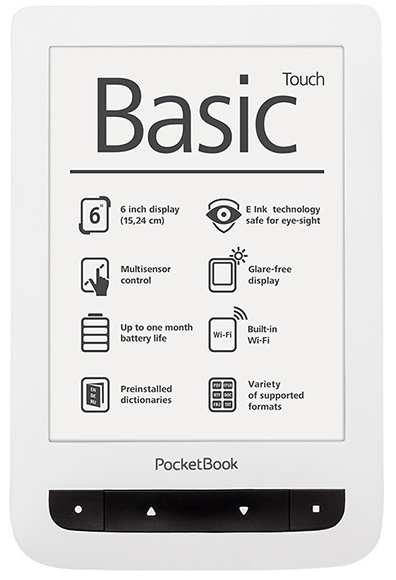
PocketBook 624 Basic Touch 2: the familiar design and simpler stuffing than the PocketBook 623 Touch 2
PocketBook 614 Basic 2 is the “continuer” PocketBook 613 Basic New: the design slightly changed, the Vizplex screen was replaced with more modern Pearl, and the memory became 4 GB instead of 2 GB. That's all the differences from its predecessor.

The next budget
PocketBook 515 Mini is a first completely new 5-inch reader since PocketBook 360. That is, the developers decided not to “finish” the PocketBook 360 again, but to develop a compact reader from scratch. It turned out quite well, considering the low price, but, as they say, with trade-offs: there is no slot for memory cards, the screen of the previous generation is E Ink Vizplex. But the color "sea wave" with an orange joystick pleased: usually readers are gray, white or black, and this version stands out against the general background.

PocketBook 515 today is the latest 5-inch pocketbook
Not in 2013, without three unusual models. You can even say "experimental." The first is PocketBook Cad Readerwith a 13.3-inch touch screen E Ink Fina, the model was shown at the conference Autodesk University 2013 in the United States. These displays were designed to “combine the benefits of TFT and E Ink. There are no other details: apparently, something went wrong with E Ink, and now Fina screens on the official website of this company are not even mentioned. According to some reports, the PocketBook tests showed that the Fina large screens - just with a 13.3-inch diagonal - are not very reliable. Therefore, the project turned. In general, the PocketBook Cad Reader could have become a very interesting product - it was assumed that architects, engineers and builders would use this professional model. She worked on the basis of Android and allowed to run AutoCAD.

PocketBook Cad Reader was supposed to be the first reader - a professional tool. But due to the peculiarities of the Fina technology (in which the E Ink company is to blame), the release of the model had to be canceled. The
second experimental product - PocketBook 801 ColorLux- I still got to the counters. He became the world's first reader with a color display E Ink Triton 2 and backlight. On the one hand, it's great that the E Ink screens have learned to be colored. On the other hand, the palette of 4,096 colors (against millions of the same smartphones and tablets) did not impress, the picture was faded. But such a reader was expensive - about two times more expensive than the basic PocketBook models with Pearl screens (about 10 thousand rubles versus 5 thousand). Therefore, the development of the theme with color electronic ink has not been received from PocketBook or from other manufacturers.
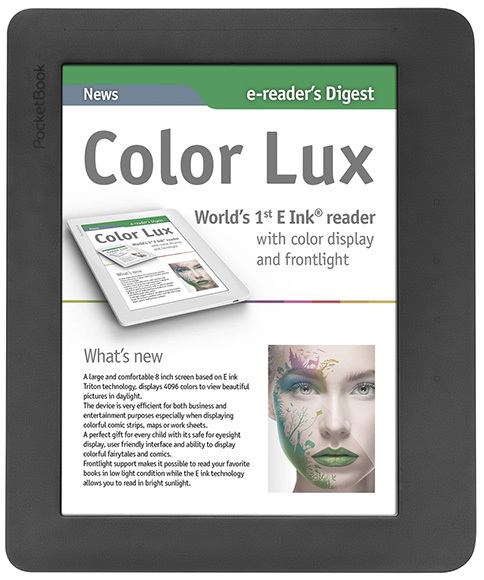
The first and last poketbook with a color screen E Ink. The topic didn’t go further: color ink is too inferior in image quality to IPS and AMOLED screens.
The third unusual product is the PocketBook Cover Reader book case for Samsung Galaxy S4 smartphone with E Ink screen. That is, a smartphone with the help of this accessory turns into a reader. Previously, no one invented anything of the kind or offered it. PocketBook Cover Reader even caused a patent dispute with the creators of the YotaPhone - the latter claimed that their patents were violated in PocketBook. As a result, the parties settled their contradictions out of court and the release of the PocketBook Cover Reader took place without any restrictions - however, already in 2014.

Unfortunately, the PocketBook Cover Reader had a very narrow “specialization”: the accessory was exclusively compatible with the Samsung Galaxy S4. It does not work with other models of the Korean company.
This year saw the light of the PocketBook 626 - in fact the update of the PocketBook 623 Touch 2, from which audio capabilities were removed (MP3 player and Text-to-Speech). But the processor frequency was raised from 800 MHz to 1 GHz, and the amount of RAM was increased from 128 to 256 MB. Plus, the battery capacity was raised from 1,000 to 1,500 mAh, which made it possible to bring the autonomy time from three weeks to one and a half months. Otherwise, everything is still: 6-inch E Ink Pearl HD screen, Wi-Fi, backlight, support for 18 formats of books and documents.
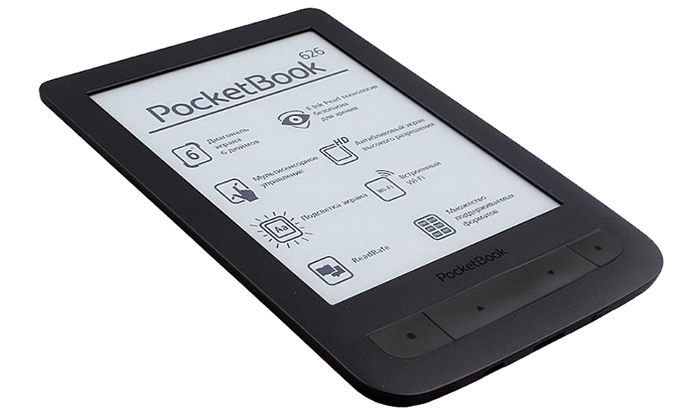
The roots of PocketBook 626 go as far as the PocketBook 622 Touch model of 2012 sample: the design has remained almost unchanged. And thank God: he is very successful, ergonomic and pleasing to the eye.
The PocketBook 630 model is the same thing as the PocketBook 626, but in a different case: the scroll buttons are now not under the screen, but on the back panel. Plus added a light sensor to automatically adjust the brightness of the backlight. Also worth noting is the version of PocketBook 630 Fashion - it came with a cover designed by the fashionable brand Kenzo.
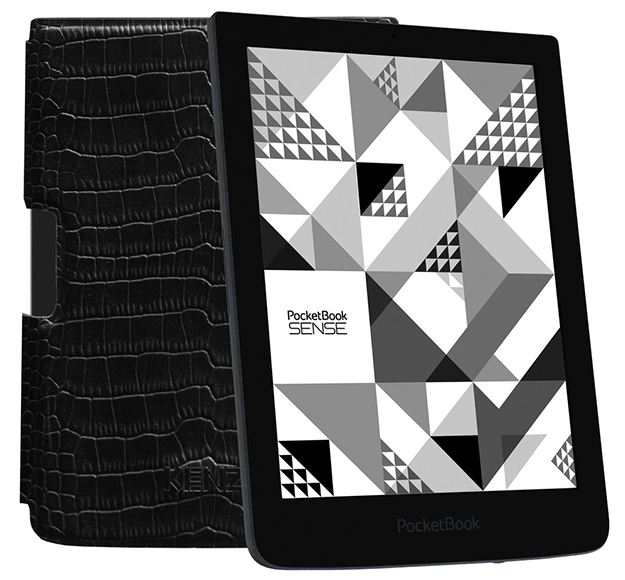
PocketBook 630 Fashion version with Kenzo fashionable leather cover
The PocketBook 650 model has its own feature: it is the world's first reader with an E Ink screen and a built-in camera (5 megapixels). With its help, you could photograph the text, recognize it and translate it into a document view. Frankly speaking: the function is cool, but it doesn’t pull to the mainstream role. Therefore, they took the PocketBook 650 only those who knew why they needed a camera in the reader. Otherwise, in terms of hardware and functions, this model differed from PocketBook 626 and 630 in the presence of an MP3 player and a new generation screen. It's about E Ink Carta - it's a little lighter and sharper than Pearl.

Before the advent of the PocketBook 650, no one ever equipped a reader with E Ink screens. The
PocketBook 840 Ink Pad is the second 8-inch reader in the history of the PocketBook after the color model PocketBook 801 Color Lux. The Ink Pad touchscreen capacitive display E Ink Pearl with a resolution of 1600 x 1200 pixels, that is perfectly suited for technical, scientific and business literature with a mass of diagrams, graphs, formulas, diagrams, tables. Of the unusual, it is worth noting the strip above the screen - this is how induction control of the backlight is implemented. Enough to hold your finger left or right - and the brightness changes. In general, this is the most sophisticated reader: with MP3-player, Text-to-Speech, Wi-Fi and other splashes.
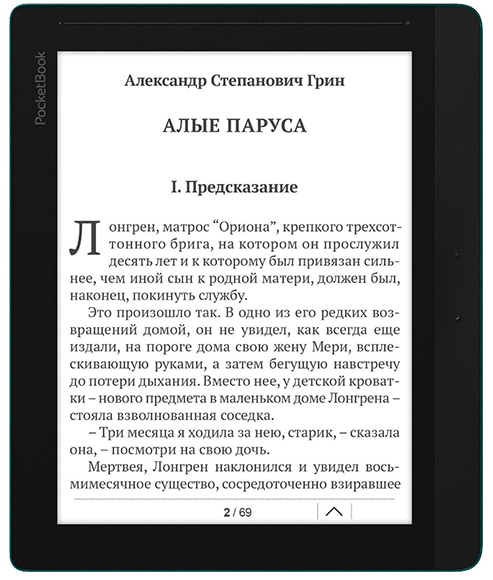
The glass covered almost the entire front panel of the PocketBook 840 Ink Pad, because of which the model resembled a tablet.
Well, the PocketBook 640 Aqua is the world's first reader with protection against water and dust according to the IP57 standard. That is, you can read it even under water. Although, of course, this is not the point: protection is needed for safe reading on the beach or in the bathroom - the device will definitely not fail. According to the characteristics: 6-inch E Ink Pearl screen (800 x 600 pixels), Wi-Fi support is implemented, but alas, there was no music player.
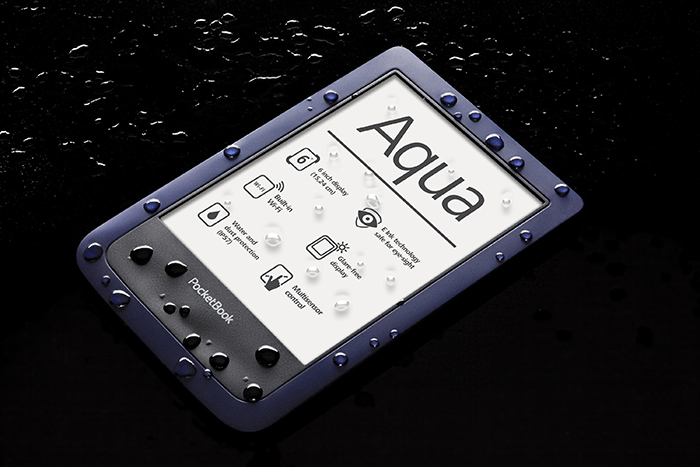
PocketBook 640 Aqua is the first in the world and definitely the best reader for reading on the beach. Neither water nor sand is terrible for him.
In 2014, the story of the PocketBook Cad Reader was continued - at the Autodesk University 2014 conference in the USA, the company showed the Cad Reader Flex . She got a flexible 13.3-inch E Ink Mobius screen. True, the screen is now non-touch, so that the new model is not designed to create some professional content, like the PocketBook Cad Reader that has passed away in the Bose and not yet born, but for its (content) learning. However, who knows - perhaps the screen will still make a touch. Because the final version of PocketBook Cad Reader Flex is still in development.

PocketBook Cad Reader Flex: flexible but no longer touch
PocketBook 626 Plus is the main novelty of 2015: the developers took the PocketBook 626 and replaced the E Ink Pearl HD display with the latest generation E Ink Carta screen. Otherwise, no changes have occurred. By the way, in the fall of 2016, PocketBook released a bright red version of this model - it is she in the photo below.

The red version, released in the fall of 2016, was named PocketBook 626 Plus Ruby Red
And in 2015, PocketBook launched a new sub-brand - Reader. Under it, the most simple readers are served without any frills like music, dictionaries, games, and so on. Model Reader Book 1 received the usual E Ink Pearl HD screen, and Reader Book 2 - touchscreen.
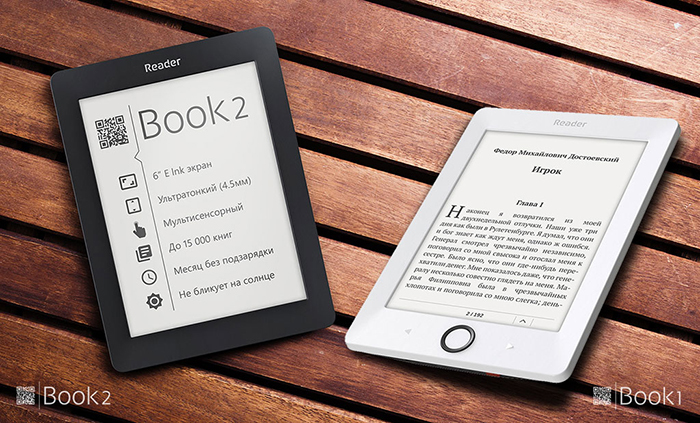
Reader Book 2 and Reader Book 1: nothing extra. But the low price: Reader models cost about a third less than models with the PocketBook brand
Well, finally we got to 2016, when in the fall the PocketBook at once updated the entire line of readers. That, given the stable and permanent leadership positions of the company in Russia, has become a central event in the reader market.
PocketBook 615 for 8,900 rubles has become the most budget reader in the company's line of backlit. A good screen (6 inches, E Ink Pearl HD technology), support for as many as 18 book formats and backlighting - in fact, this is all you need for comfortable reading.

PocketBook 615 is by far the cheapest package with a backlight.
The PocketBook 625 does not have a backlight, but it has an E Ink Carta screen (albeit with a lower resolution of 800 x 600) and Wi-Fi. If you don't need the backlight, well, or if you have an external flashlight for the reader, then you can safely take the model 625. Even save: it costs 7,900 rubles.
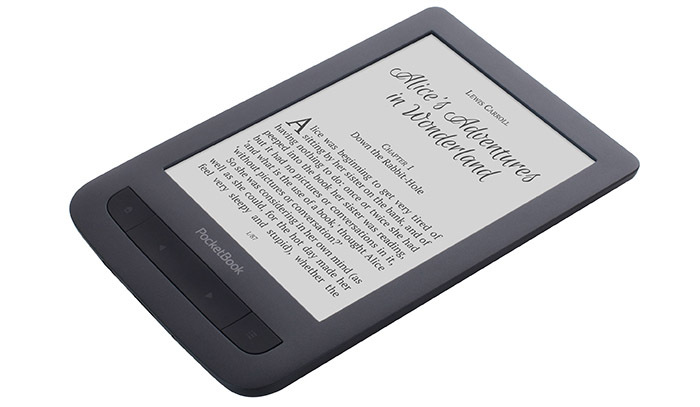
PocketBook 625 has retained the
PocketBook 631 Touch HD design that has already become a classic for pocketbooks - this is the flagship of the line: it contains all the most up-to-date technologies and options available for readers to date. 6-inch E Ink Carta HD screen with a resolution of 1448 x 1072 pixels (more on models with such a form factor does not happen), music, Wi-Fi, Text-to-Speech, backlight - in general, the full set. Plus, a new design: previously, packages in this package have never been released. There is a model of 12,500 rubles. Yes, not very cheap, but, I repeat, this is the most functional reader in the line.

PocketBook 631 Touch HD - the most sophisticated and technological poketbook in the entire history of the company.
Well, it remains to mention PocketBook 840 Ink Pad 2 . This is a new version of PocketBook 840 Ink Pad 2014 sample. The glass now covers not the entire front panel, but only the screen, due to which a) the picture clarity has increased and b) the reader's weight has decreased from 350 to 305 g. The control keys have become more convenient, but the induction strip for adjusting the brightness has disappeared - users have not appreciated it . It is right: why complicate the device, if you can adjust the backlight from the screen. The price of the model is 17 900 rubles.

The 8-inch PocketBook Ink Pad 2 is the biggest reader in the current line of the company
****
I don’t know which of these to conclude. I will say this: I used the PocketBook 301, and now I am holding the PocketBook 631 Touch HD in my hands. Eight years have passed - and the difference in technology and quality of implementation of functions between these models is enormous. But it is pleasant to use both the first reading room and the second one. This means that in PocketBook they do not deviate from certain standards, which the company itself asked when it entered the market. This helped her to eventually become a leader in her field in Russia, overtaking the same Amazon (which is understandable - see the review-comparison of “Pocket” and “Kindla”. And outside of Russia - one of the strongest players: PocketBook models are sold in more than 40 countries, and in the world PocketBook ranks third in the ranking of the largest players in the reader market after Amazon and Kobo.
As a bonus, I offer just such a picture - it indicates the years of the appearance of various technologies and options in poker books. A picture for those who are too lazy to read this towel and immediately went to the conclusions;)
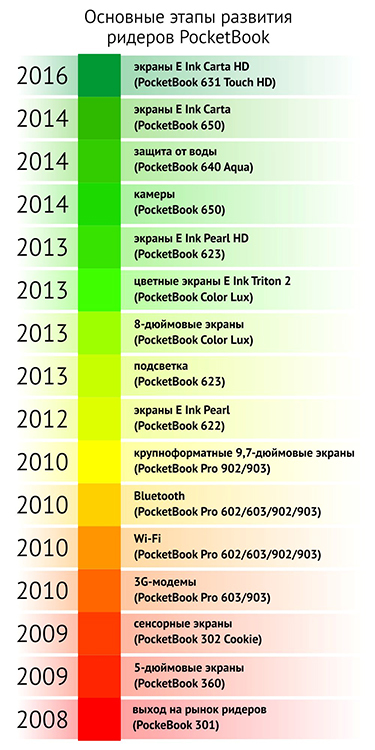
Technical characteristics of all serial readers mentioned in the post:

Clickable

Clickable

Clickable
It is worth emphasizing that the ruble prices for PocketBook models have grown much slower than the dollar exchange rate since the company entered the market. The following chart reflects the fact that PocketBook is well aware of the impossibility of linking prices to the dollar, as this will make readers much less accessible to the public. (Under the large format should be understood models with a diagonal of 8 and 9.7 inches, under compact - 5 and 6 inches).
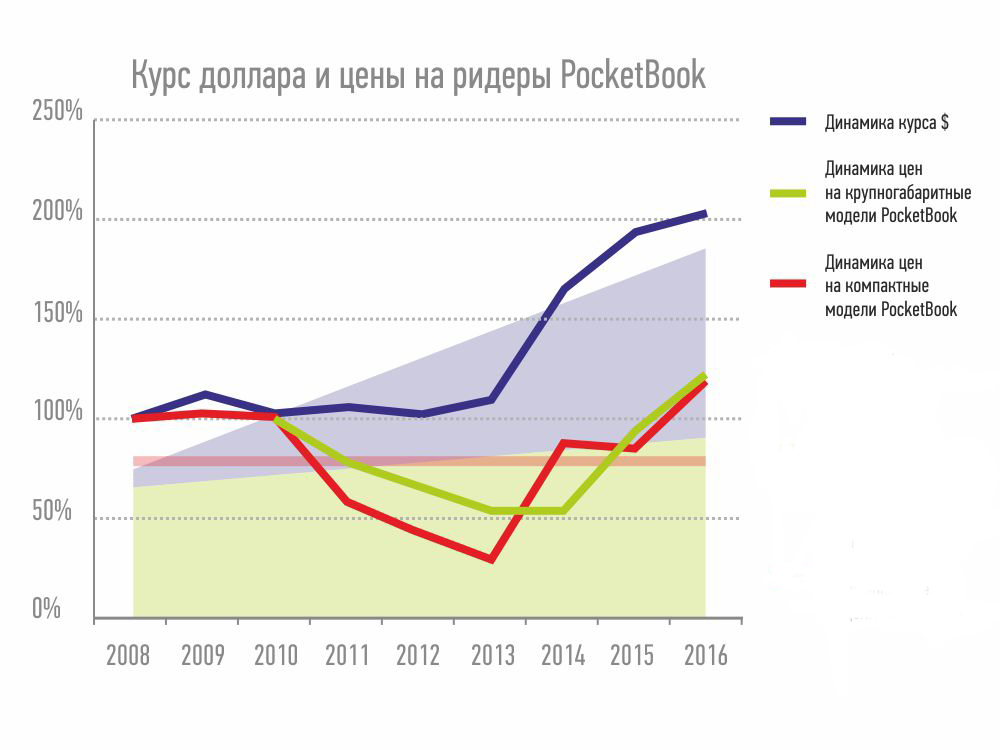

In the meantime, let's imagine that in the yard ...
2008
That year, PocketBook entered the reader market. The company's firstborn, the PocketBook 301 model , became a real hit: in two years or more, by the end of 2010, more than 100 thousand copies of the device were sold in Russia alone. Given that the entire volume of the Russian market of book readers for these three years (2008, 2009, 2010) was estimated by analysts at less than one million. That is, PocketBook 301 - only one model, for a minute - in terms of sales, it took more than 10% of the total domestic reader market. Thus, PocketBook 301 has become the most popular reader in Russia in the history of this class of gadgets. And to break the record in the future, no other model failed.

PocketBook 301 - reader with record sales. Offered in several versions. Some went with a memory card and a cover, and some had a minimum grade
We will not hide: there were certain claims to PocketBook 301. In particular, individual users complained about the unreliability of E Ink. Like, almost a finger hit him - and he took and broke. (And replacing the display at that time cost about 70% of the price of a new reader - and it was easier to buy a new reader than to change the screen.) This really was the case, but the blame should be not PocketBook, but the company E Ink, the manufacturer of similar displays. Its developments of that time really did not differ in reliability. And users blamed PocketBook only because of the popularity of the PocketBook 301 model, although the problem with the “battle” of the screens was absolutely for all reader brands. If, say, Samsung sells a million smartphones, of which 1% will be defective, then theoretically 10 thousand users can write about it on the Internet. But HTC, for example, will sell 100 thousand smartphones, and the level of marriage it will be exactly the same - 1%. How many people can face it (marriage)? That's right, a thousand. That's the same with the PocketBook 301: this model was sold at times better than others, and therefore the noise on the Internet due to problems with the displays of this particular model was much more than about the reader of other brands.

PocketBook 301 was available even in glamorous pink colors - 7 years before the iPhone 6s!
Anyway, the PocketBook 301 still continued to buy almost avidly. Because, firstly, this reader was the most thoughtful software - one support for 12 formats of books was worth. By the way, in the future, the number has grown to a maximum for the market - as much as 18; and that's against Kindle 6 and 10-12 for most other competitors.
The software design of the PocketBook 301 model is a consequence of the presence in the PocketBook team of the backbone of programmers from the countries of the former USSR, namely from Russia, Ukraine, Belarus. They perfectly understood and understand the domestic realities - for example, the need for support by the reader FB2, the most popular book format in the CIS. In Amazon, for example, they don’t see any point in supporting FB2, because they don’t care about Russian realities. Secondly, PocketBook 301 as a whole was a high-quality, complete product without obvious “jambs”. This is very important, since it was then, in 2008–2009, that a “reader boom” began in Russia, and everything from China began to carry reading rooms. And most of them brought that slag that-it was painful to watch. PocketBook, on the contrary, set a very high level of quality. What exactly and led to an avalanche-like growth in sales of the first model, and then to leadership: by 2011, PocketBook already controlled about 40% of the electronic reader market. By 2016, the share of PocketBook on the Russian reader market has increased, almost to 70%.
year 2009
This year, the PocketBook has already released two new readers. The first was the model PocketBook 360. In the case of PocketBook 301, they took the finished development of Netronix (in particular, the case and hardware) and, after finishing it thoroughly from the software and engineering points of view, got the PocketBook 301 itself. But the PocketBook 360 is a completely authentic development - the model was made from scratch, since in 2009, Pocket acquired its own fully formed team of hardware engineers. This was the key difference between the PocketBook and all the players of the Russian reader market at the time: they brought devices with their own logo from China (in 99% of cases, the devices were crooked, oblique and of poor quality), but the PocketBook has since trusted the Asians only. The development of the devices was carried out up to now, that is, up to the present moment, is conducted by the specialists of the company.

PocketBook 360 - the first reader in the world, developed according to the wishes of consumers. It was completed with a cover to protect the screen
PocketBook engineers created a theme on the-ebook.org Russian forum and collected user suggestions for three months - the latter thought and wrote what they would like to see in the new reader model. The result was PocketBook 360 - the first and so far the only reader in the world, entirely created on the basis of the wishes of ordinary people. The model was made compact, 5-inch, plus they implemented a number of extremely unusual for that time chips. For example, a plastic cover for the screen - it protected the display from various objects in bags, pockets and backpacks. And for the first time in PocketBook 360 (in the case of readers, of course) a gyroscope was implemented: the image on the screen automatically rotated depending on the position of the reader in space. Hence, in fact, the number 360 in the title. Plus, the design of the PocketBook 360 was very pleasant: In general, the reading rooms of that time looked scary, but this model could be called pretty - including thanks to the pattern on the protective cover. This reader was eagerly bought by the girls, who, in addition to the design of the attractive design, were attracted by the compactness of the PocketBook 360 - the reader could easily fit even into a miniature handbag.
The second novelty of 2009 is PocketBook 302 Cookie . It’s also an innovative reader in many respects: it became the first touchscreen (though resistive - that is, not very convenient) pokerbook. In addition, PocketBook 302 Cookie immediately offered five options for downloading books to memory: from the Internet via Wi-Fi (it was a simple browser), from a computer or smartphone via Bluetooth, from a computer using a cable, as well as via a MicroSD card and USB flash drives. Most of these methods were later abandoned: the Internet has become faster and more accessible, and MicroSD is now no more expensive than conventional USB flash drives. So Bluetooth and USB host are no longer needed. But then, in 2009, PocketBook 302 Cookie in terms of convenience and technology tore all competitors to shreds.

PocketBook 301 Cookie could be controlled with both fingers and a stylus. But the pen reader listened better, given the resistive touchscreen technology.
2010
This year was very successful for PocketBook - in the sense that the company released a whole galaxy of successful models. Namely, the Pro line, which included PocketBook Pro 602, 603, 902 and 903 . All of these models were made in factories Foxconn - Taiwanese company that assembles the iPhone, iPad and other Apple products.
PocketBook Pro 603 and 903 models have become the world's first readers with a full smartphone set of wireless modules - Bluetooth, Wi-Fi and 3G. Yes, yes, it was possible to insert a SIM-card into the reader and then buy e-books in the company's PocketBook-BookLand store (which, by the way, has since been pre-installed into all PocketBook readers with access to the Web). Well, just to surf the Internet through the browser, too, no one forbade. Actually, why was 3G needed if the readers supported Wi-Fi? Well, today Wi-Fi is almost in every first cafe and even in buses and subways, but then, in 2010, with free networks everything was a bit more complicated. And to ensure constant and uninterrupted access to the Internet, 3G was indispensable. Later, with the final popularization of Wi-Fi, PocketBook from 3G modems in the readers completely refused.

The package of PocketBook Pro 603 and 903 left pen. The models looked the same, unless, of course, we take into account the dimensions. In the picture - PocketBook Pro 603.
Also PocketBook Pro 603 and 903 received inductive touch screens - with support for stylus control. Such displays did not react to the fingers, but the pen presses were processed much more accurately than the PocketBook 302 Cookie with its resistive screen. Well, here, perhaps, I would say that PocketBook Pro 902 and 903 were the company's first readers in a large-format 9.7-inch form factor. Such a hefty reader with high resolution (1200 x 825 pixels) for technical and scientific literature, which, due to the presence of a heap of small symbols, requires just large screens.
PocketBook Pro 602 and 902 did not have touch screens and 3G modems. Otherwise, they did not differ from their more expensive counterparts - PocketBook Pro 603 and 903, respectively.

Well, this is PocketBook Pro 902. Model PocketBook Pro 602 looks the same, only more compact.
All Pro-series models have rear panels made from magnesium-aluminum alloy: this significantly increased the torsional rigidity of the cases and, as a result, almost completely solved the problem of cracked screens E Ink, which took place in the early models of the company. However, the solution with the above-mentioned alloy was temporary: 6-inch PocketBook Pro 602 and 603 weighed 255 and 280 g, respectively. That for models in such a form factor is quite a lot: today 6-inch diagonal billboards weigh about 180 g. In general, steps were required from E Ink, which was supposed to increase the reliability of its screens. However, E Ink will only do this in a year.
It is worth noting the presence in PocketBook Pro 602, 603, 902 and 903 of a number of audio features. If ordinary MP3 players were also in PocketBook 301 and PocketBook 301 Cookies, then “proshki” also received the ability to play text by voice - the Text-to-Speech function. That is, ordinary books by the software of the reader could turn into audiobooks, which previously no single reader of any other manufacturer could do.
And in PocketBook Pro 602, 603, 902 and 903 for the first time (and not only for PocketBook models, but also for the reader market as a whole), ABBYY dictionaries and a number of other manufacturers appeared, which are still used in all PocketBook models. The principle of operation of the dictionaries is this: you highlight a word in the text - and then you get a translation. Later, this implementation became the standard for the reader market, and it was happy to “beat” dozens of other companies.

Back in 2010, the first wave of attempts to introduce readers into schools as electronic textbooks began. Anatoly Chubais himself compared in his blog the reader Plastic Logic 100 from RUSNANO with PocketBook Pro 902 - they say, let's see which one is better suited for the needs of education. Of course, Anatoly Borisovich won his native Rosnan Plastic Logic. However, the Plastic Logic 100 project eventually died, and was not born, but PocketBook readers — however, models 903, not 902 — were successfully implemented in a number of schools in Russia and Ukraine. Then, in 2010, a prototype reader for PocketBook 901 schools was created.. It was originally created for educational institutions, that is, from scratch, it was not based on any other reader. PocketBook believed that it was better for schools to create a separate product, but the success of the implementations in schools of PocketBook Pro 903 showed that it is quite possible to do without a completely new model represented by PocketBook 901. Therefore, massively this model, alas, was not released.

PocketBook 901 occasionally met in stores, although they didn’t start mass production of this model
2011
2011 was, so to speak, a year of evolution: PocketBook offered only one radically new model, plus well-updated old ones. For example, PocketBook 360 Plus has replaced the legendary PocketBook 360 : the processor frequency has increased from 400 to 533 MHz, and Wi-Fi support has been added. On this updated reader, for the sake of demonstrating the power of iron, they even launched Doom II - for the first time on devices with E Ink screens, a game with such 3D graphics was launched:

PocketBook 360 Plus has become faster than its predecessor and has learned how to access the Internet, as well as play Doom II
Models PocketBook Pro 612 and 912 - this is a cross between 602/603 and 902/903, respectively. PocketBook Pro 612 and 912 have lost 3G modems, however, inductive touchscreens remain in them. PocketBook Pro 912 was also released in the Education version - with an electronic diary and other applications necessary for the school. The model also experienced a number of successful implementations in educational institutions.

The new line of "proshki" included only two models - PocketBook Pro 612 and 912. Both with touch screens, but without 3G modems.
But the PocketBook 611 Basic became a radically new model in 2011 . It was the first time that new E Ink screens were used in it - with the same image quality as before, but less fragile. This allowed to abandon the protective covers and metal in the enclosures. Therefore, the 6-inch PocketBook 611 Basic weighed only 175 g - as much as 80 g less than the same PocketBook Pro 602.

PocketBook 611 Basic has become the first reader with an improved E Ink screen - not in terms of image quality, but in terms of reliability. This allowed for a lightweight plastic case.
year 2012
What did PocketBook do this year? First, they made PocketBook 611 Basic cheaper - the PocketBook 613 Basic New model was released . The essence is the same, but with minor improvements in the software and without the support of Wi-Fi.

There is no Wi-Fi, a slightly different form of buttons - that's all the changes compared to PocketBook 611 Basic
Another update has undergone and PocketBook 360: PocketBook 360 Plus version was turned into PocketBook 360 Plus New . Innovation - overclocked to 800 MHz processor, which also found application in PocketBook 611 Basic, PocketBook 613 Basic New and PocketBook 622 Touch.

A faster processor is the only significant difference between the PocketBook 360 Plus New and the previous version called PocketBook 360 Plus.
Actually, PocketBook 622 Touch- the third and most important novelty of 2012. This model was the first poketbukom screen E Ink Pearl and the first - with a capacitive touchscreen and support for multitouch. That is, it was possible to scale the text by mixing and spreading fingers, which is very convenient. Just like on the iPad. The case of the PocketBook 622 Touch is plastic, as is the case with the Basic series models - due to the increased reliability of the E Ink screens and the competent design of the cases from the PocketBook side, the problem of “combat” of displays began to appear rarely. Among other features of the PocketBook 622 Touch, it is worth noting support for Wi-Fi, an MP3 player, Text-to-Speech, and a new design that has become classic, which has been used with minimal edits so far.

PocketBook 622 Touch was the first among the PocketBooks to receive the E Ink Pearl screen. Plus, he got a design that later became a classic for most of the company's 6-inch sensor readers.
It is also worth remembering about the first of its kind service for bibliophiles ReadRate - its first test version was launched in 2012 (the final one in 2014). It allows people to talk about recently read books and publications that they only plan to meet, as well as learn about the book habits of their friends. In addition, the function of "likes" and comments, as well as integration with other social networks. By the end of 2016, ReadRate has about 160 thousand users - this is not very much compared to VKontakte and some Odnoklassniki, where millions go by, and still quite a lot to find a good book for yourself.
year 2013
This year was extremely fruitful. Firstly, it is worth noting the fact that PocketBook has begun to massively use E Ink Pearl screens in its devices - lighter, clearer and more generally better. In all the models described above, except for PocketBook 622 Touch, E Ink Vizplex screens were installed - they were quite good for their time (better than the same Sipix), but they are inferior to Pearl at least in image clarity.
PocketBook 623 Touch 2Received not just the E Ink Pearl screen (800 x 600 pixels), but Pearl HD (1024 x 758 pixels). And the backlight system - for the first time for Pocketbooks. Plus, synchronization with Drobpox appeared: you throw a book on the computer into a folder - and it appears in the reader after a minute. In general, the flagship of the 2013 model. Moreover, the model is relevant to this day - for example, the author of this text still exploits PocketBook 623 Touch 2. And it is not going to change it for anything. Just because the reader is not a tablet, the readers do not lose their relevance a year later, and after two, and after five. Reducing the capacity of the battery does not make them worse (well, the reader worked for a month, and then three weeks sal - is the difference great?), And the display quality of the books does not change with time.

PocketBook 623 Touch 2 - the first backlit with the backlight and the first with the E Ink Pearl HD screen.
The PocketBook 624 Basic Touch is also released in 2013. By design, it is similar to the PocketBook 623 Touch 2, but there is no backlight and MP3-player embracing Text-to-Speech - for the sake of lower prices. Well, the screen has a resolution of 800 x 600 pixels, not 1024 x 758. That is, the PocketBook 624 Basic Touch 2 had the usual Pearl, not the Pearl HD. But the hardware platform is slightly more powerful: the processor frequency was raised from 800 MHz to 1 GHz.

PocketBook 624 Basic Touch 2: the familiar design and simpler stuffing than the PocketBook 623 Touch 2
PocketBook 614 Basic 2 is the “continuer” PocketBook 613 Basic New: the design slightly changed, the Vizplex screen was replaced with more modern Pearl, and the memory became 4 GB instead of 2 GB. That's all the differences from its predecessor.

The next budget
PocketBook 515 Mini is a first completely new 5-inch reader since PocketBook 360. That is, the developers decided not to “finish” the PocketBook 360 again, but to develop a compact reader from scratch. It turned out quite well, considering the low price, but, as they say, with trade-offs: there is no slot for memory cards, the screen of the previous generation is E Ink Vizplex. But the color "sea wave" with an orange joystick pleased: usually readers are gray, white or black, and this version stands out against the general background.

PocketBook 515 today is the latest 5-inch pocketbook
Not in 2013, without three unusual models. You can even say "experimental." The first is PocketBook Cad Readerwith a 13.3-inch touch screen E Ink Fina, the model was shown at the conference Autodesk University 2013 in the United States. These displays were designed to “combine the benefits of TFT and E Ink. There are no other details: apparently, something went wrong with E Ink, and now Fina screens on the official website of this company are not even mentioned. According to some reports, the PocketBook tests showed that the Fina large screens - just with a 13.3-inch diagonal - are not very reliable. Therefore, the project turned. In general, the PocketBook Cad Reader could have become a very interesting product - it was assumed that architects, engineers and builders would use this professional model. She worked on the basis of Android and allowed to run AutoCAD.

PocketBook Cad Reader was supposed to be the first reader - a professional tool. But due to the peculiarities of the Fina technology (in which the E Ink company is to blame), the release of the model had to be canceled. The
second experimental product - PocketBook 801 ColorLux- I still got to the counters. He became the world's first reader with a color display E Ink Triton 2 and backlight. On the one hand, it's great that the E Ink screens have learned to be colored. On the other hand, the palette of 4,096 colors (against millions of the same smartphones and tablets) did not impress, the picture was faded. But such a reader was expensive - about two times more expensive than the basic PocketBook models with Pearl screens (about 10 thousand rubles versus 5 thousand). Therefore, the development of the theme with color electronic ink has not been received from PocketBook or from other manufacturers.

The first and last poketbook with a color screen E Ink. The topic didn’t go further: color ink is too inferior in image quality to IPS and AMOLED screens.
The third unusual product is the PocketBook Cover Reader book case for Samsung Galaxy S4 smartphone with E Ink screen. That is, a smartphone with the help of this accessory turns into a reader. Previously, no one invented anything of the kind or offered it. PocketBook Cover Reader even caused a patent dispute with the creators of the YotaPhone - the latter claimed that their patents were violated in PocketBook. As a result, the parties settled their contradictions out of court and the release of the PocketBook Cover Reader took place without any restrictions - however, already in 2014.

Unfortunately, the PocketBook Cover Reader had a very narrow “specialization”: the accessory was exclusively compatible with the Samsung Galaxy S4. It does not work with other models of the Korean company.
year 2014
This year saw the light of the PocketBook 626 - in fact the update of the PocketBook 623 Touch 2, from which audio capabilities were removed (MP3 player and Text-to-Speech). But the processor frequency was raised from 800 MHz to 1 GHz, and the amount of RAM was increased from 128 to 256 MB. Plus, the battery capacity was raised from 1,000 to 1,500 mAh, which made it possible to bring the autonomy time from three weeks to one and a half months. Otherwise, everything is still: 6-inch E Ink Pearl HD screen, Wi-Fi, backlight, support for 18 formats of books and documents.

The roots of PocketBook 626 go as far as the PocketBook 622 Touch model of 2012 sample: the design has remained almost unchanged. And thank God: he is very successful, ergonomic and pleasing to the eye.
The PocketBook 630 model is the same thing as the PocketBook 626, but in a different case: the scroll buttons are now not under the screen, but on the back panel. Plus added a light sensor to automatically adjust the brightness of the backlight. Also worth noting is the version of PocketBook 630 Fashion - it came with a cover designed by the fashionable brand Kenzo.

PocketBook 630 Fashion version with Kenzo fashionable leather cover
The PocketBook 650 model has its own feature: it is the world's first reader with an E Ink screen and a built-in camera (5 megapixels). With its help, you could photograph the text, recognize it and translate it into a document view. Frankly speaking: the function is cool, but it doesn’t pull to the mainstream role. Therefore, they took the PocketBook 650 only those who knew why they needed a camera in the reader. Otherwise, in terms of hardware and functions, this model differed from PocketBook 626 and 630 in the presence of an MP3 player and a new generation screen. It's about E Ink Carta - it's a little lighter and sharper than Pearl.

Before the advent of the PocketBook 650, no one ever equipped a reader with E Ink screens. The
PocketBook 840 Ink Pad is the second 8-inch reader in the history of the PocketBook after the color model PocketBook 801 Color Lux. The Ink Pad touchscreen capacitive display E Ink Pearl with a resolution of 1600 x 1200 pixels, that is perfectly suited for technical, scientific and business literature with a mass of diagrams, graphs, formulas, diagrams, tables. Of the unusual, it is worth noting the strip above the screen - this is how induction control of the backlight is implemented. Enough to hold your finger left or right - and the brightness changes. In general, this is the most sophisticated reader: with MP3-player, Text-to-Speech, Wi-Fi and other splashes.

The glass covered almost the entire front panel of the PocketBook 840 Ink Pad, because of which the model resembled a tablet.
Well, the PocketBook 640 Aqua is the world's first reader with protection against water and dust according to the IP57 standard. That is, you can read it even under water. Although, of course, this is not the point: protection is needed for safe reading on the beach or in the bathroom - the device will definitely not fail. According to the characteristics: 6-inch E Ink Pearl screen (800 x 600 pixels), Wi-Fi support is implemented, but alas, there was no music player.

PocketBook 640 Aqua is the first in the world and definitely the best reader for reading on the beach. Neither water nor sand is terrible for him.
In 2014, the story of the PocketBook Cad Reader was continued - at the Autodesk University 2014 conference in the USA, the company showed the Cad Reader Flex . She got a flexible 13.3-inch E Ink Mobius screen. True, the screen is now non-touch, so that the new model is not designed to create some professional content, like the PocketBook Cad Reader that has passed away in the Bose and not yet born, but for its (content) learning. However, who knows - perhaps the screen will still make a touch. Because the final version of PocketBook Cad Reader Flex is still in development.

PocketBook Cad Reader Flex: flexible but no longer touch
2015
PocketBook 626 Plus is the main novelty of 2015: the developers took the PocketBook 626 and replaced the E Ink Pearl HD display with the latest generation E Ink Carta screen. Otherwise, no changes have occurred. By the way, in the fall of 2016, PocketBook released a bright red version of this model - it is she in the photo below.

The red version, released in the fall of 2016, was named PocketBook 626 Plus Ruby Red
And in 2015, PocketBook launched a new sub-brand - Reader. Under it, the most simple readers are served without any frills like music, dictionaries, games, and so on. Model Reader Book 1 received the usual E Ink Pearl HD screen, and Reader Book 2 - touchscreen.

Reader Book 2 and Reader Book 1: nothing extra. But the low price: Reader models cost about a third less than models with the PocketBook brand
2016 year
Well, finally we got to 2016, when in the fall the PocketBook at once updated the entire line of readers. That, given the stable and permanent leadership positions of the company in Russia, has become a central event in the reader market.
PocketBook 615 for 8,900 rubles has become the most budget reader in the company's line of backlit. A good screen (6 inches, E Ink Pearl HD technology), support for as many as 18 book formats and backlighting - in fact, this is all you need for comfortable reading.

PocketBook 615 is by far the cheapest package with a backlight.
The PocketBook 625 does not have a backlight, but it has an E Ink Carta screen (albeit with a lower resolution of 800 x 600) and Wi-Fi. If you don't need the backlight, well, or if you have an external flashlight for the reader, then you can safely take the model 625. Even save: it costs 7,900 rubles.

PocketBook 625 has retained the
PocketBook 631 Touch HD design that has already become a classic for pocketbooks - this is the flagship of the line: it contains all the most up-to-date technologies and options available for readers to date. 6-inch E Ink Carta HD screen with a resolution of 1448 x 1072 pixels (more on models with such a form factor does not happen), music, Wi-Fi, Text-to-Speech, backlight - in general, the full set. Plus, a new design: previously, packages in this package have never been released. There is a model of 12,500 rubles. Yes, not very cheap, but, I repeat, this is the most functional reader in the line.

PocketBook 631 Touch HD - the most sophisticated and technological poketbook in the entire history of the company.
Well, it remains to mention PocketBook 840 Ink Pad 2 . This is a new version of PocketBook 840 Ink Pad 2014 sample. The glass now covers not the entire front panel, but only the screen, due to which a) the picture clarity has increased and b) the reader's weight has decreased from 350 to 305 g. The control keys have become more convenient, but the induction strip for adjusting the brightness has disappeared - users have not appreciated it . It is right: why complicate the device, if you can adjust the backlight from the screen. The price of the model is 17 900 rubles.

The 8-inch PocketBook Ink Pad 2 is the biggest reader in the current line of the company
****
I don’t know which of these to conclude. I will say this: I used the PocketBook 301, and now I am holding the PocketBook 631 Touch HD in my hands. Eight years have passed - and the difference in technology and quality of implementation of functions between these models is enormous. But it is pleasant to use both the first reading room and the second one. This means that in PocketBook they do not deviate from certain standards, which the company itself asked when it entered the market. This helped her to eventually become a leader in her field in Russia, overtaking the same Amazon (which is understandable - see the review-comparison of “Pocket” and “Kindla”. And outside of Russia - one of the strongest players: PocketBook models are sold in more than 40 countries, and in the world PocketBook ranks third in the ranking of the largest players in the reader market after Amazon and Kobo.
As a bonus, I offer just such a picture - it indicates the years of the appearance of various technologies and options in poker books. A picture for those who are too lazy to read this towel and immediately went to the conclusions;)

Technical characteristics of all serial readers mentioned in the post:

Clickable

Clickable

Clickable
It is worth emphasizing that the ruble prices for PocketBook models have grown much slower than the dollar exchange rate since the company entered the market. The following chart reflects the fact that PocketBook is well aware of the impossibility of linking prices to the dollar, as this will make readers much less accessible to the public. (Under the large format should be understood models with a diagonal of 8 and 9.7 inches, under compact - 5 and 6 inches).

